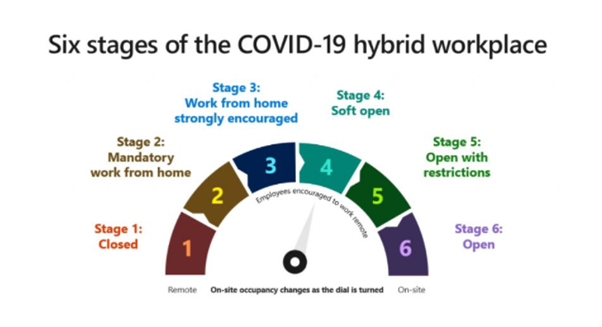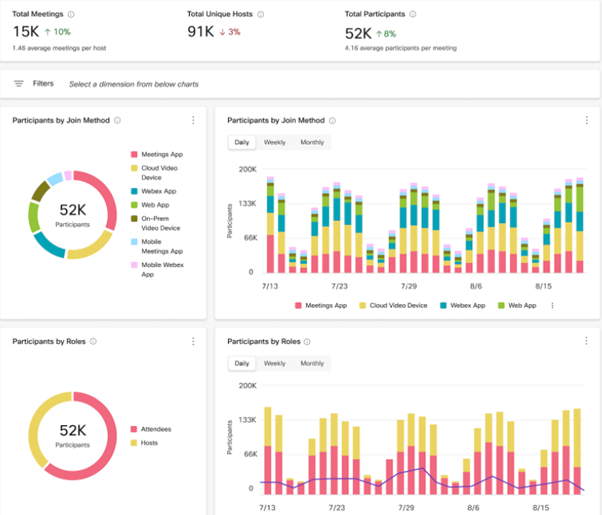There’s a saying that ‘The only constant in life is change’. Change has been constant in the modern workplace since the onset of a pandemic, which breathed new life into the term ‘hybrid’. There’s very little possibility of a return to the way things were, as workers globally navigate a new culture and a rapidly evolving workplace.
 Image source: Microsoft
Image source: Microsoft
What is a hybrid workplace?
Most people reading this are probably working in one right this moment. That is, an organization that supports a distributed workforce of both in-office and remote employees.
A hybrid collaboration environment is multi-faceted and dynamic, consisting of multiple communication platforms and deployments and various components and devices.
The rapid proliferation of hybrid working came about as a necessity in response to the pandemic. But more generally, hybrid working ideally aims to combine an optimal balance of increased job satisfaction and reduced stress for employees and management.
Get more insight into why user experience is so critical in the hybrid, digital workplace.

What are the challenges in the hybrid workplace?
A hybrid workplace can help build a crisis-resilient culture by allowing increased freedom and autonomy around when and where to work. It can provide flexibility within an organization while maintaining structure, depending on how the dynamic is executed. But hybrid working comes with some fundamental flaws too:
Technical issues
- Inconsistent quality or remote network connections
- In-office corporate networks not prepared to handle increased demands of hybrid work, particularly video
- Incompatible devices
- Sub-par audio and video
- Workspaces not optimized for hybrid collaboration – both home workspaces and in-office meeting spaces
- Security risks when faced with managing multiple devices and networks
- The absence of immediate on-site technical support
Social and cultural issues
- Difficulty separating home life from work life
- Feelings of personal isolation or social alienation
- Reluctance or difficulty embracing hybrid communication technology
- A reduction in motivation and team morale
- Difficulty in maintaining company culture
- Unclear performance metrics
- Distractions and reduced supervision and direction
How the biggest organizations are approaching hybrid work
For a hybrid workplace to realize all the advantages, organizations and service providers need to be agile and flexible enough to accommodate the nuances. At the same time, they need to encourage growth while nurturing the health and wellbeing of their employees.
Microsoft, for example, has released some resources for workers and business leaders that detail what they’re learning while adopting a hybrid work model. Microsoft Teams is one of the world’s most popular collaboration tools, helping organizations enable hybrid work and maintain business continuity.
With a deeply entrenched belief in a positive customer experience, they’ve constructed roadmaps to help workers thrive in a hybrid environment and empower employers to support their teams.
Cisco has also been developing their Webex collaboration tool, providing capabilities to empower teams to brainstorm, co-create and solve problems. They’ve also developed their analytics tool, allowing users clear, easy-to-follow insights and performance metrics. With a dedicated drive to nurture creativity along with collaboration, Webex tools have been fine-tuned for hybrid work.
 Source: Cisco
Source: Cisco
Another big player, Zoom, is also working tirelessly on the evolution of its communication and collaboration tools to foster better connectivity between remote workers.
AI-enabled meetings, smart galleries, shareable virtual whiteboards, and live video editing capabilities are all helping make the virtual meeting experience as good, if not better, than in person.
Zoom’s CIO, Harry Mosely, says, “There’s no question that innovation is at the center of everything we’re doing going forward.”
Key considerations in the hybrid workplace
There are three key elements for organizations to focus on if they’re to achieve a seamless, sustainable transition to adopting an ongoing hybrid workplace.
Culture
The people-first culture in the workplace is now more critical than ever. Employees shouldn’t be subjected to inefficient processes and schedules, so business leaders need to be mindful that hybrid working will be embraced by some and challenging to manage for others.
- A culture based on transparency and trust is essential, so open communication with employees is paramount.
- The nature of hybrid working means collaboration is asynchronous, so everyone needs access to information that allows them to do their job in real-time.
- Empathy and understanding are crucial from both an employer and an employee’s point of view. Offering flexible working options can make a huge difference to an entire workplace dynamic.
- Technical support and ongoing training should be readily available for those workers who need it.
Innovation
Every workplace is different, and their needs are varied. Some workers perform better in an office environment, while others thrive in a remote situation. Hybrid working is all about doing things differently. To knit the two environments together, business leaders need to consider innovation:
- By equipping employees with the right tools and technical solutions they need for a great user experience.
- Technology is evolving rapidly, so IT managers need to stay on top of the most modern communication methods.
- Business leaders need to ensure adequate training and support for all levels of workers, for example, during cloud migration or the addition of new UC applications.
Performance
For a hybrid workplace to thrive, IT leaders need to simplify complexity and make sure tools work seamlessly. Downtime caused by malfunctioning equipment or poor-quality connectivity can cause unnecessary stress for everyone, whether in the office or at home.
The primary consideration is to provide a healthy level of certainty and quality assurance with ongoing support.
Success in the hybrid workplace
One way to achieve this is with the deployment of third-party performance management solutions. With the disparate nature of hybrid working, a UC environment could consist of dozens or even hundreds of different applications, devices, networks and locations.
It’s vital to see an entire collaboration ecosystem, monitor performance in real-time, and have the means to respond to problems immediately.
Third-party monitoring tools also allow you to view metrics, collect essential data and provide insights and analytics that can make the difference between success or failure in the hybrid workplace.





